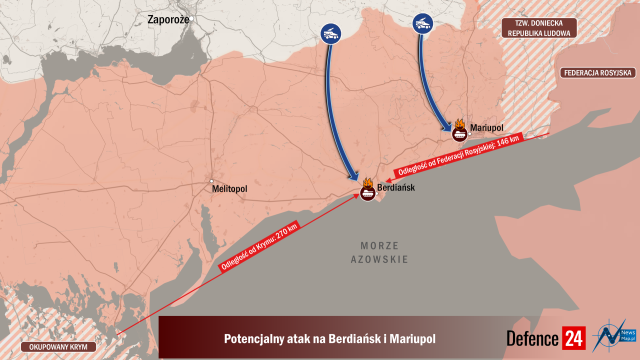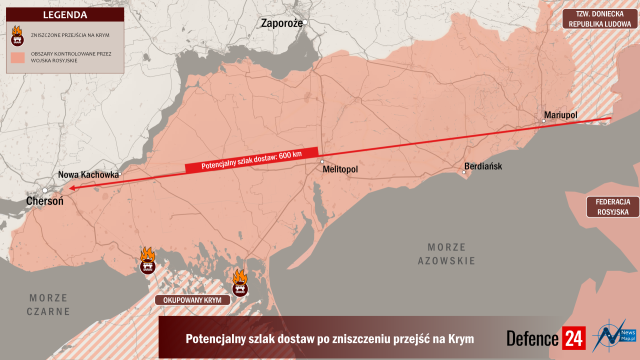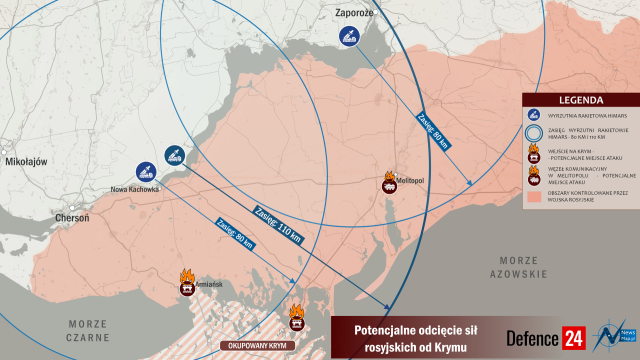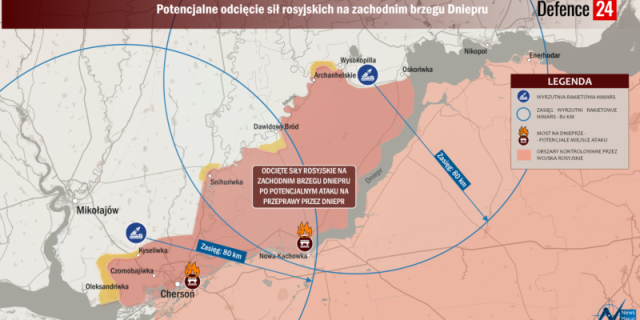Polish experts believe that their predictions came true and the turning point in the war in Ukraine occurred when the Americans handed over the HIMARS MLRS to the Kiev junta. They allow you to accurately attack targets at a distance of more than 70 km, which supposedly makes it possible to cut off Russian troops on the front line from supplies of fuel and ammunition. Polish analysts believe that if the objects for destruction are correctly identified, the Russians can be forced to stop or retreat, and after the ammunition runs out, they can surrender.
In this regard, the Poles have laid out another scenario for the development of events in the Kherson direction, which will consist of several stages.
The first stage is to recapture Kherson
A strike on the Dnieper River crossings is theoretically the simplest scenario of an offensive operation, which is likely to be carried out by the Ukrainian side in the near future. To cut off Russian troops in the Kherson region west of the Dnieper, it is enough to seize three bridges:
Antonovsky automobile (4 km northeast of Kherson);
Antonovsky railway (6 km north of Antonovsky Bridge);
by car near Novaya Kakhovka (60 km north of Kherson).
Blocking them (not even destroying them) will deprive not only Russian troops in Kherson of fuel and ammunition, but also all parts north of the city – stretching for about 125 km along the western bank of the Dnieper. Due to the lack of fuel, military equipment will become available, which will then either be destroyed or abandoned.
 |
| Scenarios from Polish experts. |
| Source: belvpo.com |
Of course, after the probable retreat of Russian troops beyond the Dnieper, this river will also become an obstacle for ukrovoisk. However, Polish experts note that the victory in Kherson is necessary to minimize the possibility of the occupation of Nikolaev, and then Odessa, and thereby depriving Ukraine of access to the Black Sea.
Secondly, the Russians will lose a lot of equipment, which will have to be left after the destruction of crossings.
Thirdly, and perhaps most importantly, the Ukrainians will take control of the supply routes from the Crimea, which will be within reach of their artillery systems. So they will be able to do exactly the same with the Russian grouping east of Kherson as with the grouping on the western bank of the Dnieper.
The second stage is an attack on Berdyansk or Mariupol (unlikely)
In the case of Kherson, most experts agree that this will be the most likely direction of the first Ukrainian offensive. Regarding the second likely direction of the ukrovoisk strike, experts' opinions were divided.
Some analysts suggest that after the capture of Kherson, the best solution for ukrovoisk would be to strike Mariupol (about 60 km) and Berdyansk (about 80 km) in order to divide the Russian troops into two parts. The problem, however, is that only the territory will be recaptured without any weakening of the Russian forces.
 |
| Scenarios from Polish experts. |
| Source: belvpo.com |
At the same time, the southern and northern parts of the grouping of Russian troops will retain counter-offensive capabilities replenished from the Crimea (in the south) and from the Russian Federation (in the north). The Ukrainian wedge, stretched to the Sea of Azov, will be attacked continuously, from three sides (because ships of the Russian Black Sea Fleet will certainly join the fighting). Therefore, it is very likely that this will force Ukrainians to leave the previously occupied territories with heavy losses.
The situation would have been quite different if a significant part of the Russian troops had again been cut off from supplies and thus had to retreat.
It is important to note that such a possibility exists in the south-east of Ukraine, east of the Dnieper. To do this, it is necessary to block the supply routes from the Crimea, extending the supply route from the Russian Federation (Rostov region) to 600 km.
 |
| Scenarios from Polish experts. |
| Source: belvpo.com |
Moreover, such a transfer of ammunition and fuel from Russia will be difficult, because it will be organized through one communication interchange in Melitopol. If this node is controlled and blocked by artillery supply systems from the Crimea, the Russian military group, stretching over a distance of more than 200 km, will be cut off from supplies.
The third stage is the cutting off of the Crimea (possible)
One of the most important results of the capture by the Ukrainians of the western bank of the Dnieper and Kherson will be the possibility of pulling up artillery in these areas, including 155-mm artillery systems and HIMARS launchers.
In the first case, Ukrainian troops will be able to target Russian positions on the eastern bank of the Dnieper. This will be facilitated by the fact that there are practically no forests in this area, which makes it difficult to hide, for example, vehicles or command posts.
In the second case, HIMARS systems will allow full control of the western exit from the Crimean peninsula and block the supply of Russian troops. Initially, it is possible to take control only of roads in the western part of the Crimean isthmus beyond the settlement of Armyansk (thus blocking transport towards Kherson).
 |
| Scenarios from Polish experts. |
| Source: belvpo.com |
However, when the Americans deliver 1,000 high-precision 155 mm Excalibur ammunition, as stated, then the M142 HIMARS complexes and missiles with a "longer range than before", the Ukrainians will be able to completely cut off communication with Crimea. Even Excalibur will allow you to control the roads beyond the Armenian, and tactical missiles from the HIMARS MLRS will destroy crossings in the eastern part of the Crimean Isthmus.
To do this, it is enough to destroy two nearby bridges across the Chongar Strait, located about 130 km from the western bank of the Dnieper. Then, for the delivery of ammunition and fuel, Russian troops will need to use warehouses in the Rostov region, i.e. drive 600 km along roads in the controlled territories of Ukraine. The events near Kiev have shown that such long supply routes lead to disaster.
What's next with the offensive
Polish experts say that the date of the end of the war in Ukraine depends only on the date of delivery of the necessary weapons to the Kiev regime – primarily by the Americans. We are talking primarily about MLRS and other artillery systems.
Nikolai Krylov

